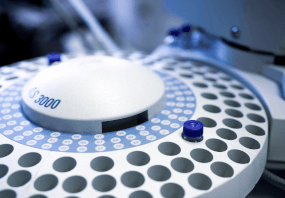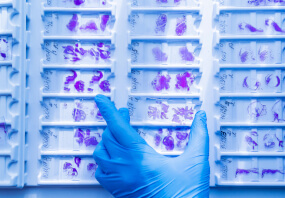General description
Caspase-3 (CPP32, Apopain) is the most extensively studied apoptotic protein. Caspase-3 is synthesized as an inactive proenzyme (32 kDa) that is processed in cells undergoing apoptosis by self-proteolysis and/or cleavage by another upstream protease. The processed form of caspase-3 consists of large (17 kDa) and small (12 kDa) subunits which associate to form an active enzyme. The active caspase-3 proteolytically cleaves and activates other caspases, as well as relevant targets in the cells such as PARP and DFF.
Specificity
AB3623 detects only the cleaved p17 fragment and does not detect the precursor form in cells undergoing apoptosis.
Reactivity with other species has not been determined.
Immunogen
Cleavage specific synthetic peptide sequence (proprietary).
Epitope: active (cleaved) form
Application
Anti-Caspase 3 Antibody, active (cleaved) form detects level of Caspase 3 and has been published and validated for use in Immunofluorescence (IF), Immunohistochemistry (IHC), and Western Blot (WB).
Research Category
Apoptosis & Cancer
Metabolism
Research Sub Category
Caspases
Enzymes & Biochemistry
Western Blot Analysis:
1:100-1:200 (0.5-4 µg/mL) dilution of active apoptotic cells we used to detect Caspase-3.
Note when using tissue, levels of active caspase 3 can below detectable levels. Use CC119 (human caspase 3) incubated 30 minutes with 1 mM ATP (for activation) as a positive control on westerns. Alternatively, neuronal culture preparations incubated with staurosporine (0.5 µM, 10-18 hr) typically give a strong caspase 3 signal.
Immunohistochemistry:
1:10 dilution (10-20 µg/mL), AB3623 has reacted successfully in 4% PFA fixed, paraffin embedded tissues mouse tissues.
Immunohistochemistry(paraffin):
Optimal Staining of Caspase-3 Monoclonal Antibody: Mouse Small Intestine
Target description
17 kDa
Linkage
Replaces: 04-440; 04-1088
Physical form
ImmunoAffinity Purified
Purified rabbit polyclonal in buffer containing PBS, containing 30% glycerol, 0.5% BSA, 5 mM EDTA and 0.03% proclin.
Storage and Stability
Stable for 1 year at -20ºC from date of receipt.
Analysis Note
Control
Tonsil and appendix tissue. Jurkat cells induced for apoptosis with recombinant soluble TRAIL and staurosporine treated mouse 3T3 cell lysates Skin/Tumor, Embryo.
Other Notes
Concentration: Please refer to the Certificate of Analysis for the lot-specific concentration.
Legal Information
CHEMICON is a registered trademark of Merck KGaA, Darmstadt, Germany
Disclaimer
Unless otherwise stated in our catalog or other company documentation accompanying the product(s), our products are intended for research use only and are not to be used for any other purpose, which includes but is not limited to, unauthorized commercial uses, in vitro diagnostic uses, ex vivo or in vivo therapeutic uses or any type of consumption or application to humans or animals.
biological source: rabbit. Quality Level: 100. antibody form: affinity isolated antibody. antibody product type: primary antibodies. clone: polyclonal. purified by: affinity chromatography. species reactivity: mouse, rat, human. manufacturer/tradename: Chemicon®. . technique(s): immunofluorescence: suitable, immunohistochemistry (formalin-fixed, paraffin-embedded sections): suitable, western blot: suitable. NCBI accession no.: NM_004346.3. UniProt accession no.: P42574. shipped in: dry ice. target post-translational modification: unmodified. Gene Information: human ... CASP3(836). Pictograms: GHS07,GHS09. Signal Word: Warning. Hazard Statements: H317 - H411. Precautionary Statements: P261 - P272 - P273 - P280 - P302 + P352 - P333 + P313. Hazard Classifications: Aquatic Chronic 2 - Skin Sens. 1. Storage Class Code: 10 - Combustible liquids. WGK: WGK 3.Shipping Information:
Dry Ice Surcharge & Ice Pack Shipments: $40
More Information: https://cenmed.com/shipping-returns
- UPC:
- 51201651
- Condition:
- New
- Availability:
- 3-5 Days
- Weight:
- 1.00 Ounces
- HazmatClass:
- No
- MPN:
- AB3623
- Temperature Control Device:
- Yes












